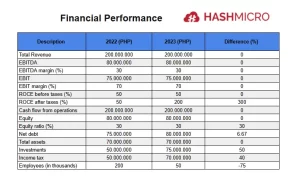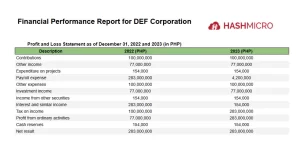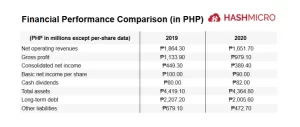In today’s competitive business landscape, understanding your company’s financial performance isn’t just a task but the foundation for growth, decision-making, and long-term success. Financial performance refers to how well a business achieves its financial goals, usually measured by key metrics such as revenue, profitability, and cash flow.
For C-suite managers and executives, paying attention to these numbers is not an option but a necessity. Strong financial performance can indicate operational efficiency, market position, and sustainability, while poor performance can signal deeper issues that require immediate attention.
In this article, we will outline the core components of financial performance, why mastering them is critical to steering your business toward success, and the template of Financial Performance. Patuloy na magbasa upang malaman kung paano ang mga pananaw na ito ay makakatulong sa paggawa ng mga desisyon na magpapalago sa iyong kumpanya.
Table of Content
Content Lists

Key Takeaways
|
What is Financial Performance?
Financial performance is a measure of a company’s ability to generate revenue, manage expenses, and make a profit over a period of time. Financial performance is typically evaluated using key financial indicators such as revenue growth, profitability, liquidity, and Return On Investment (ROI).
These metrics provide insight into a company’s financial health and operational effectiveness, helping business leaders assess how well the organization meets its financial goals and where improvements may be needed.
An efficient cloud-based accounting system allows businesses to streamline the tracking of company finances and provides access to accurate, real-time data. Understanding financial performance is critical to making strategic decisions and ensuring long-term sustainability.
Types of Financial Performance Indicators
To assess your business’s financial health, it’s crucial to understand the different types of financial performance indicators. These metrics offer valuable insights into various aspects of your business and guide informed decision-making. Below are the key types of financial performance indicators:
- Profitability indicators: Profitability indicators measure how efficiently your business is generating profits from its revenue. Common profitability ratios include gross profit margin, net profit margin, and return on assets (ROA). These metrics help you understand if your business is able to convert sales into actual profit and how well it is utilizing its assets to generate earnings.
- Liquidity indicators: Liquidity indicators assess a company’s ability to meet short-term financial obligations. The current ratio and quick ratio are key liquidity metrics. These ratios help determine whether your business has enough assets to cover its liabilities without needing to sell long-term investments.
- Leverage indicators: Leverage indicators measure the extent to which a business relies on debt to finance its operations. Debt-to-equity ratio and debt ratio are commonly used to assess financial risk. A high ratio may indicate that your business is heavily reliant on debt, which can affect long-term stability.
- Efficiency indicators: Efficiency indicators track how well a company utilizes its resources to generate sales. Metrics like inventory turnover and accounts receivable turnover help evaluate how efficiently your business manages its inventory and collects payments. These indicators are crucial for improving operational efficiency.
- Growth indicators: Growth indicators track the expansion or contraction of your business over time. Metrics like revenue growth rate and earnings per share (EPS) provide insight into how your business is growing in terms of sales, profit, and market share. These are key for understanding long-term sustainability and profitability.
How to Record Financial Performance

Here are the key steps to effectively record financial performance:
- Set clear financial goals: The first step in recording financial performance is establishing clear and specific financial goals for your business. These include targets such as increasing revenue, reducing operating costs, or improving profit margins. Having measurable goals provides a benchmark for evaluating how well the business is doing and helps guide decision-making as you move forward.
- Track revenue and expenses: It’s crucial to track all sources of income and spending in detail. This includes documenting sales, investments, other revenue streams, and costs associated with running the business, such as overhead, salaries, and supplies. By categorizing these revenue and expense items correctly, you can clearly understand your company’s cash flow and financial health at any given time.
- Use financial statements: Financial statements are key tools for recording and summarizing your company’s financial performance. The most common are the balance sheet, income statement, and cash flow statement. These documents provide an overview of your company’s financial position, showing assets, liabilities, income, expenses, and cash movement. Regularly reviewing these statements helps ensure you stay on track and understand your company’s financial situation.
- Analyze key financial ratios: Once you have your financial data, it’s essential to analyze critical financial ratios. These ratios, such as profitability, liquidity, and return on investment (ROI), give you deeper insights into specific aspects of your business’s financial health. For example, profitability ratios help you understand how well the company generates profits relative to its revenue. In contrast, liquidity ratios show how easily the business can cover its short-term obligations.
- Review and adjust regularly: Financial performance is not static, so you must review your records regularly to stay updated. By comparing your results to the goals you set earlier, you can quickly identify whether you’re on track or need adjustments.
By following these steps, you’ll be able to record and track your company’s financial performance effectively, leading to more informed decisions and greater long-term success. Additionally, using tools such as financial reporting software, will help with tracking and reviewing your performance.
Examples of Financial Performance
Below is an example of a Financial Performance template that your company can use:
Template 1 financial performance
 Template 2 financial performance
Template 2 financial performance
 Template 3 financial performance
Template 3 financial performance

Conclusion
It’s important to have the right tools in place, such as an efficient accounting system, to understand and manage your business’s financial performance effectively. Monitoring key financial indicators such as revenue, expenses, and profitability helps you make informed decisions and identify areas for improvement.
However, manually handling these tasks can be complex and time-consuming. HashMicro’s financial software simplifies this process by providing accurate, real-time financial insights through easy-to-read reports and dashboards.
With this software, you can stay on top of your business’s financial health and make proactive adjustments as needed. Take advantage of a free demo today to see how HashMicro can support your business’s financial management and help you make smarter, data-driven decisions.

Frequently Asked Questions About Financial Performance
-
Why is financial performance important?
It provides insights into a company’s profitability, efficiency, and financial health, helping stakeholders make informed decisions about investments, operations, and strategies.
-
Can financial performance predict future success?
While strong financial performance often indicates a well-managed company, it’s not a guarantee of future success as market conditions and other factors can influence outcomes.
-
How does financial performance impact stakeholders?
Positive financial performance can lead to increased investor confidence, employee satisfaction, and better supplier relationships, while poor performance may raise concerns about the company’s sustainability.



































